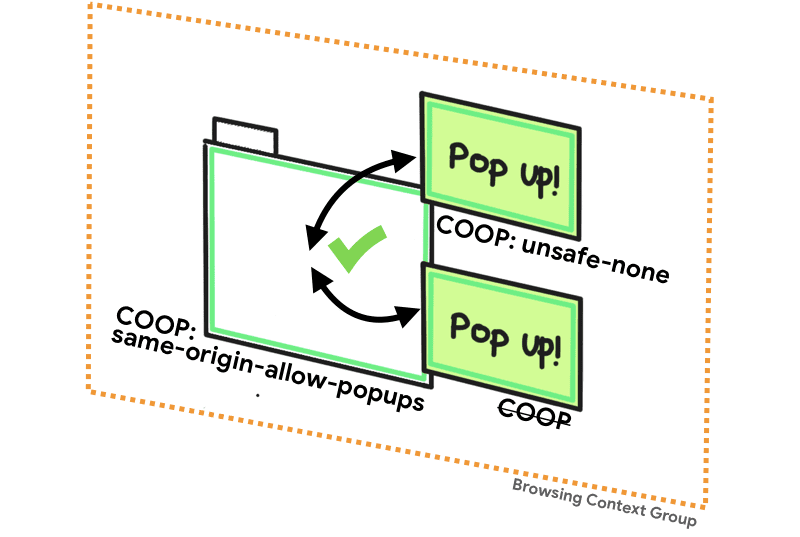Find out why cross-origin isolation is necessary to use powerful features like SharedArrayBuffer, performance.measureMemory()and the API de autoperfilado de JS.
Safe and secure
Introduction
En Cómo hacer que su sitio Web be «aislado de origen cruzado» utilizando COOP y COEP, explicamos cómo adoptar el estado «aislado de origen cruzado» utilizando COOP y COEP. Este es un artículo complementario que explica por qué se requiere el aislamiento de origen cruzado para habilitar funciones potentes en el browser.
Key term:
This article uses many similar sounding terminologies. To clear things up, let's define them:
Background
La web se basa en la política del mismo origen: una característica de seguridad que restringe la forma en que los documentos y los scripts pueden interactuar con recursos de otro origen. Este principio restringe las formas en que los sitios web pueden acceder a los recursos de origen cruzado. Por ejemplo, un documento de https://a.example cannot access the data hosted on https://b.example.
However, the same-origin policy has had some historical exceptions. Any website can:
- Embed cross-origin iframes
- Include cross-origin resources like images or scripts
- Open cross-origin pop-ups with a DOM reference
If the web could be designed from scratch, these exceptions would not exist. Unfortunately, when the web community realized the key benefits of a strict same-origin policy, the web was already relying on these exceptions.
The security side effects of such a lax same-origin policy were corrected in two ways. One way was by introducing a new protocol called Cross-origin resource sharing (CORS)
cuyo propósito es asegurarse de que el server permita compartir un recurso con un origen determinado. La otra forma es eliminando implícitamente el acceso directo del script a los recursos de origen cruzado mientras se conserva la compatibilidad con versiones anteriores. Estos recursos de origen cruzado se denominan recursos «opacos». Por ejemplo, esta es la razón por la que manipular los píxeles de una imagen de origen cruzado mediante CanvasRenderingContext2D
fails unless CORS is applied to the image.
All of these policy decisions are happening within a group of navigation context.

Durante mucho tiempo, la combinación de CORS y recursos opacos fue suficiente para que los browsers fueran seguros. A veces, casos extremos (como JSON vulnerabilities) were discovered and needed to be patched, but overall the principle of not allowing direct read access to raw bytes from cross-origin resources was successful.
All of this changed with
Spectrum, which makes any data that is loaded into the same navigation context group as your code potentially readable. Yes evil.com embeds a cross-origin image, they can use a Specter attack to read your pixel data, rendering protections that rely on "opacity" ineffective.

Idealmente, todas las solicitudes de origen cruzado deben ser examinadas explícitamente por el servidor propietario del recurso. Si el servidor propietario de los recursos no proporciona la verificación, los datos nunca llegarán al grupo de contexto de navegación de un actor maligno y, por lo tanto, permanecerán fuera del scope de cualquier ataque de Spectre que pueda llevar a cabo una página web. Lo llamamos un estado aislado de origen cruzado. Esto es exactamente de lo que se trata COOP + COEP.
In an isolated cross-origin state, the requesting site is considered less dangerous and this unlocks powerful features like SharedArrayBuffer,
performance.measureMemory and the JS Self-Profiling API that could otherwise be used for Specter-like attacks. Also avoid modifying document.domain.
Cross Origin Embedding Policy
Cross-Origin Embedding Policy (COEP) Prevents a document from loading cross-origin resources that do not explicitly grant the document's permission (using CORP or CORS). With this function, you can declare that a document cannot load such resources.

Para activar esta política, agregue el siguiente encabezado HTTP al documento:
require-corpthe require-corp The keyword es el único valor aceptado para COEP. Esto aplica la política de que el documento solo puede cargar recursos del mismo origen o recursos marcados explícitamente como cargables desde otro origen.
For resources to be loaded from another source, they must support Cross-Origin Resource Sharing (CORS) or Cross-Origin Resource Policy (CORP).
Cross-origin resource sharing
If a cross-origin resource supports Cross-origin resource sharing (CORS), you can use the
crossorigin
attribute
to upload it to your website without being blocked by COEP.
<img src="https://third-party.example.com/image.jpg" crossorigin>Por ejemplo, si este recurso de imagen se sirve con headers CORS, use el
crossorigin attribute para que la solicitud para obtener el recurso utilice CORS mode. This also prevents the image from loading unless you set CORS headers.
Similarly, you can get cross-origin data through the fetch () method, which requires no special handling as long as the server responds with the correct HTTP headers.
Cross Origin Resource Policy
Cross Origin Resource Policy (CORP)
it was originally introduced as an option to protect your resources from being uploaded by another source. In the context of COEP, CORP can specify the resource owner's policy on who can upload a resource.
the Cross-Origin-Resource-Policy header takes three possible values:
same-siteResources that are marked same-site it can only be uploaded from the same site.
same-originResources that are marked same-origin it can only be loaded from the same source.
cross-originResources that are marked cross-origin can be uploaded to any website. (This value was added to the CORP specification along with COEP.)
Once you add the COEP header, you cannot bypass the restriction using service workers. If the document is protected by a COEP header, the policy is honored before the response enters the document process, or before it enters the service worker who is controlling the document.
Cross Origin Opening Policy
Cross Origin Opening Policy (COOP) allows you to ensure that a top-level window is isolated from other documents by placing them in a different browsing context group, so that they cannot directly interact with the top-level window. For example, if a document with COOP opens a pop-up window, its
window.opener the property will be null. He too .closed property of the opener reference will return true.

the Cross-Origin-Opener-Policy header takes three possible values:
same-originDocuments that are marked same-origin you can share the same navigation context group with documents of the same origin that are also explicitly marked same-origin.

same-origin-allow-popupsA top-level document with same-origin-allow-popups retains references to any of your pop-ups that do not set COOP or choose to break out of isolation by setting a COOP of unsafe-none.

unsafe-noneunsafe-none is the default and allows the document to be added to its opener's scan context group unless the opener has a COOP of same-origin.
the
noopener
The attribute has an effect similar to what you would expect from COOP, except that it works only from the opener side. (You cannot unlink your window when opened by a third party.) When attached noopener doing something like
window.open(url, '_blank', 'noopener') or <a target="_blank" rel="noopener">, you can deliberately disassociate your window from the open window.
While noopener can be replaced by COOP, it is still useful when you want to protect your website in browsers that do not support COOP.
Summary
If you want guaranteed access to powerful features like SharedArrayBuffer,
performance.measureMemory o JS self-profiling API, just remember that your document must use COEP with the value of require-corp and COOP with the value of same-origin. In the absence of any of them, the browser will not guarantee sufficient isolation to safely enable those powerful features. You can determine the status of your page by checking whether
self.crossOriginIsolated
returns true.
Learn the steps to implement this in How to make your website "cross-origin isolated" using COOP and COEP.
Means






